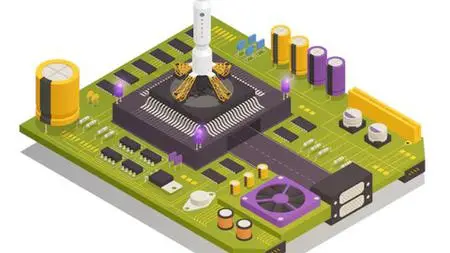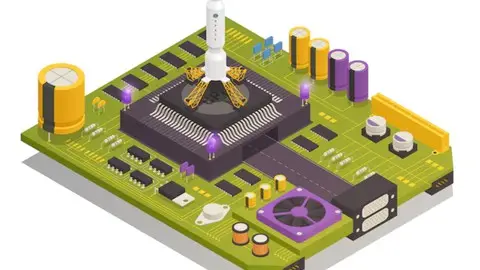Complete Course On Electronic Devices And Circuits
Published 12/2022
MP4 | Video: h264, 1280x720 | Audio: AAC, 44.1 KHz
Language: English | Size: 4.90 GB | Duration: 20h 45m
Published 12/2022
MP4 | Video: h264, 1280x720 | Audio: AAC, 44.1 KHz
Language: English | Size: 4.90 GB | Duration: 20h 45m
Learn about all electronic devices from ground up level and understand the importance of these devices in our daily life
What you'll learn
Evolution of atomic structure.
Active/Passive components and their specifications.
Semi-conductors and their classifications.
Working principles of P-N Junction diode and Zener diode.
Bi-polar junction transistor types and their operation principles.
Biasing conditions for different configuration circuits.
Field effect transistor types and their working principles.
Special purpose diodes/transistors.
Requirements
All topics will be explained from the ground up. There are no pre-requisites though some general knowledge of electronics will be beneficial. You will also learn while watching without getting bored.
Description
Electronics gives us an opportunity not only to understand the world around us, but to also interact with it, and to create whole new realities of our own.Electrical and electronic engineers work at the forefront of practical technology, improving the devices and systems we use every day. This course is also designed and to meet all those requirements in need.This is an introductory course which about the different types of electronic devices that are being used in our day- to - day life. For this there is no need of any previous knowledge just if you know a little bit of physics is more than enough. Do you know this? Electrical and electronic engineers work at the forefront of practical technology, improving the devices and systems we use every day. The benefits of electronics in our lives have saved people a lot of time, effort and money, because they mostly use savings systems.In the complete course on Electronic Devices and circuits, you will learn about atomic structure(valence electrons), passive & active components ,Transistors & their types ,FET and their classifications, Special purpose diodes .Along with these there are problems provided for each topic. Not only this there are multiple quizzes for you after each lecture.
Overview
Section 1: What is meant by electronics?
Lecture 1 BASICS OF ELECTRONICS
Lecture 2 VOL-CURRENT-RESISTANCE
Lecture 3 ENERGY BAND DIAGRAM
Lecture 4 CLASSIFICATION OF MATERIALS
Section 2: Types of semiconductors
Lecture 5 INTRINSIC SEMICONDUCTOR
Lecture 6 EXTRINSIC SEMICONDUCTOR
Section 3: Passive components
Lecture 7 INTRODUCTION TO RESISTOR
Lecture 8 TYPES OF RESISTORS
Lecture 9 READING VALUES OF RESISTOR
Lecture 10 CAPACITOR
Lecture 11 TYPES OF CAPACITORS
Lecture 12 SPECIFICATIONS OF CAP
Lecture 13 READING VALUES OF CAP
Lecture 14 INDUCTOR
Lecture 15 WORKING OF INDUCTOR
Lecture 16 TYPES OF INDUCTORS
Lecture 17 SPECIFICATIONS OF INDUCTOR
Lecture 18 READING VALUES OF INDUCTOR
Section 4: PN Junction diode
Lecture 19 INTRO TO PN JUN DIODE
Lecture 20 ENER BAND DIA FOR PN
Lecture 21 FORWARD BIAS P-N JUNDIODE
Lecture 22 REVERSE BIAS PN JUNDIODE
Lecture 23 current com of p-n jun diode
Lecture 24 PN JUNTION DIODE EQU
Lecture 25 DIODE-RESISTANCE
Lecture 26 TEMP DEPE OF PN JUN DIODE
Lecture 27 TRANSITION CAPACITANCE
Lecture 28 DIFFUSION CAPACITANCE
Lecture 29 DIODE EQU CIR-PN DIODE
Lecture 30 BREAKDOWN MECH-PN
Lecture 31 TEMP-DEP ON BD-PN
Section 5: Zener diode
Lecture 32 ZENER DIODE
Lecture 33 CHARA OF ZENER DIODE
Lecture 34 SPECIFICATIONS OF ZENER DIODE
Lecture 35 EQU CIRCUITS -ZENER DIODE
Lecture 36 EFFECT OF TEMP-ZENER DIODE
Lecture 37 BREAKDOWN MEC -ZENER DIODE
Lecture 38 ADV-DISADV-APP-ZENER DIODE
Lecture 39 APP OF ZENER DIODE
Lecture 40 ZENER AS VOL REGULATOR
Section 6: Rectifiers and their types
Lecture 41 INTRODUCTION TO RECTIFIER
Lecture 42 TYPES OF RECTIFIER
Lecture 43 HALF-WAVE RECTIFIER
Lecture 44 CHAR OF HALF WAVE RECTIFIER
Lecture 45 full wave rectifier
Lecture 46 CHARACTERISTICS OF FULL WAVE RECTIFIER
Lecture 47 BRIDGE WAVE RECTIFIER
Lecture 48 CHAR OF BRIDGE REC
Section 7: Comaparisons b/w different types of rectifiers
Lecture 49 COMP BET CENTER BRIDGE REC
Lecture 50 COMP BET REC CIRCUITS
Section 8: Filters and their types
Lecture 51 INTRODUCTION TO FILTERS
Lecture 52 CAPACITOR INPUT FILTER
Lecture 53 FULL WAVE CAP INPUT FILTER
Lecture 54 BRIDGEWAVE REC WITH CAP
Lecture 55 EXP FOR CAP INPUT FILTER
Lecture 56 SURGE CURRENT
Section 9: Inductor filter
Lecture 57 INTRO TO INDUCTOR FILTER
Lecture 58 L-SECTION FILTER
Lecture 59 BLEEDRE RESISTANCE
Lecture 60 MULTIPLE L -SECTION FILTER
Lecture 61 COMP BET CAPAC AND LC FILTER
Section 10: Clc filters
Lecture 62 CLC- FILTER
Lecture 63 EXP FOR RIPPLE FACTOR-CLC
Section 11: Vol reg power supply
Lecture 64 VOLTAGE POWER SUPPLY
Lecture 65 PARA OF POWER SUPPLY
Lecture 66 TYPES OF VOLTAGE REGU
Lecture 67 COMP BET SERIES- SH VOL REG
Lecture 68 COMP BET REC AND REG
Lecture 69 ANAL OF ZENER VOL REG
Lecture 70 PTROTE CIRCUIT - ZENER DIODE
Section 12: Transistors
Lecture 71 INTRODUCTION TO TRANSISTORS
Lecture 72 CONSTRUCTION OF TRANSISTOR
Lecture 73 OPERATING REG TRANS
Lecture 74 TRANSISTOR VOLATGES
Lecture 75 TRANSISTOR CURRENTS
Lecture 76 RELATIONSHIP BET TRANS COMP
Section 13: Types of transistor
Lecture 77 TRANSISTOR AS AMPLIFIER
Lecture 78 NPN TRANSISTOR
Lecture 79 PNP TRANSISTOR
Lecture 80 COMPARISON BETWEEN NPN AND PNP
Section 14: Transistor configurations
Lecture 81 TRANSISTOR CONFIGURATIONS
Lecture 82 CB CONFIGURATION
Lecture 83 INPUT CHAR OF CB
Lecture 84 OUTPUT CHARACTERISTICS -CB
Lecture 85 CE CONFIGURATION
Lecture 86 INPUT CHARACTERISTICS-CE
Lecture 87 OUTPUT CHARACTERISTICS-CE
Lecture 88 CC CONFIGURATION
Lecture 89 INPUT CHARACTERISTICS-CC
Lecture 90 OUTPUT CHARACTERISTICS_CC
Section 15: Adv/dis/app and problem on trans configuration
Lecture 91 PROBLEMS ON TRANSISTOR CONF
Lecture 92 ADV-DISADV-TRANSISTOR
Lecture 93 APPLICATIONS OF TRANSISTOR
Lecture 94 COMPARISON BET TRANSISTOR CONF
Section 16: Biasing of transistor
Lecture 95 INTRODUCTION TO BIASING
Lecture 96 A.C LOAD LINE
Lecture 97 D.C LOAD LINE
Lecture 98 PROBLEMS ON LOAD LINES
Lecture 99 OPERATING POINT CRITERIA
Lecture 100 STABILIZATION
Section 17: Biasing techniques
Lecture 101 FIXED BIAS CIRCUIT
Lecture 102 STABILITY FACTORS-FB
Lecture 103 ADV-DISADV-APP-F.B
Lecture 104 COLLECTOR FEEDBACK BIAS
Lecture 105 STABILTY FACTOR-CB
Lecture 106 ADV-DISADV-APP-CB
Lecture 107 VOLTAGE-DIVIDER BIAS
Lecture 108 STABILITY FACTORS-VOL DIV BIAS
Lecture 109 ADV-DISADV-APP-VOL DIV BIAS
Section 18: Compensation techniques
Lecture 110 DIODE COMPENSATION TECH
Lecture 111 THERMISTOR COMPENSATION
Lecture 112 SENSISTOR COMPENSATION
Section 19: Thermal Electronics
Lecture 113 THERMAL RUNAWAY
Lecture 114 THERMAL RESISTANCE
Lecture 115 THERMAL STABILITY
Section 20: Unipolar junction transistor
Lecture 116 UJT INTRODUCTION
Lecture 117 UJT CHARACTERTISTICS
Lecture 118 ADV-DISADV-APP-UJT
Lecture 119 UJT RELAXATION OSCILLATOR
Section 21: Special purpose diodes
Lecture 120 SCHOTTKY DIODE
Lecture 121 CHAR OF SCHOTTKY DIODE
Lecture 122 ADV-DISADV-APP-SCH DIODE
Lecture 123 VARACTOR DIODE
Lecture 124 CHARA OF VARACTOR DIODE
Lecture 125 ADV-DISA-APP-VAR DIODE
Lecture 126 PHOTO DIODE
Lecture 127 CHARA OF PHOTO DIODE
Lecture 128 ADV-DIS-APP-PHOTO DIODE
Lecture 129 LED
Lecture 130 CHARACTERISTICS OF LED
Lecture 131 ADV-DISADV-APP-LED
Lecture 132 TUNNEL DIODE
Lecture 133 WORKING OF TUNNEL DIODE
Lecture 134 CHARA OF TUNNEL DIODE
Lecture 135 ADV-DIS-APP-TUNNEL DIODE
Section 22: Silicon controlled rectifier
Lecture 136 SILICON CON RECTIFIER
Lecture 137 WORKING OF SCR
Lecture 138 CHARACTERISTICS 0F SCR
Lecture 139 ADV-DIASADV-APP-SCR
Lecture 140 SCR CROWBAR CIRCUIT
Lecture 141 SINGLE PHASE HWR - SCR
Lecture 142 SINGLE PHASE FWR-SCR
Lecture 143 COMP BET HWR AND FWR -SCR
Lecture 144 PROBLEMS ON SCR
Lecture 145 SMALL SIGNAL OF PHOTO DIO
Lecture 146 SENSITI OF ILLUM FOR PD
Lecture 147 PHOTO DIODE AS VOLTAIC CELL
Section 23: Small signal low freq model
Lecture 148 SMALL SIGNAL LOW FRE MODEL
Lecture 149 DETER OF H-PARAM
Lecture 150 ANALYSIS OF H-PARAMETERS
Lecture 151 CE-AMPLIFIER H-PARAMETER
Lecture 152 CC AMPLIFIER-H-PARAMETER
Lecture 153 CB-AMPLIFIER-H-PARAMETER
Section 24: Simplified model of small signal
Lecture 154 SIMPLIFIED MODEL OF CE AMP
Lecture 155 PROB ON CE SIMP MODEL
Lecture 156 SIMP MODEL OF CC AMP
Lecture 157 PROB ON SIMPLIFIED CC AMP
Lecture 158 SIMP MODEL OF CB AMP
Lecture 159 PROB ON SIM CB MODEL
Lecture 160 MILLERS THEOREM
Section 25: Junction field effect transistor
Lecture 161 INTRODUCTION TO JFET
Lecture 162 CONSTRUCTION OF JFET
Lecture 163 OPERAT OF N-CHANNEL JFET
Lecture 164 EXPR FOR PINCH-OFF VOLTAGE
Lecture 165 PARAMETERS OF JFET
Lecture 166 TRANS CHAR OF N-CHAN JFET
Lecture 167 DRAIN CHAR OF N-CHAN JFET
Lecture 168 CHARS OF P-CHANNEL JFET
Lecture 169 ADV-DISADV-APP-FET
Lecture 170 ADV-DISADV-APP-JFET
Lecture 171 COMP BET P AND N-CHANNEL
Lecture 172 COMP BET BJT AND FET
Section 26: Metal oxide semiconductor fet
Lecture 173 INTRODUCTION TO MOSFET
Lecture 174 INTRO TO N-CHAE D - MOSFET
Lecture 175 OPER OF N-CHAEL D-MOSFET
Lecture 176 OPER OF P-CHAEL D-MOSFET
Lecture 177 INTRODUCTION TO E-MOSFET
Lecture 178 OPERA OF N-CHA E-MOSFET
Lecture 179 OPERA OF P-CHAL E-MOSFET
Lecture 180 COMP BET JFET AND MOSFET
Lecture 181 COMP BET D-MOS AND E-MOS
Lecture 182 OPERATION OF P-CHANNEL JFET
Lecture 183 COMP BET NAND P-CHA MOS
Section 27: Fet amplifier
Lecture 184 COMM SOURCE FET AMP
Lecture 185 COM SOURCET FET-BYPASSED
Lecture 186 COMM SOURCE FET SELF-BIAS-UN
Lecture 187 COM SOURCE FET AMP-VOL DIV
Lecture 188 COM SOURCE FET AMP-VOL-DIV
Lecture 189 COMMON DRAIN FET AMP
Section 28: Generlized fet amplifier
Lecture 190 GENERALISED FET AMPLIFIER
Lecture 191 BIASING FET AMPLIFIER
Lecture 192 VOL DIVI FET BIAS AMP
Lecture 193 SELF-BIAS FET AMPLIFIER
Lecture 194 GRAPHICAL SOL FOR FET AMP
Lecture 195 BIASI FOR ZERO DRIFT CURRENT
Lecture 196 DERIVATION FOR ZERO CURRENT
Lecture 197 BIASING AGAI DEVICE VAR
Lecture 198 FET AS VOL CONT RESISTOR
Lecture 199 EXP FOR SAT DRAIN CURRENT
Lecture 200 SLOPE TRAN CHAR AT IDSS
Students who study in the departments of electronics, electrical and computer engineering.,Electronics communication engineering students.,Diploma students.,12th class students (physics).,Any one interested in electrical-electronics as a hobby and curious.,Students studying in related departments of faculty of technology.



